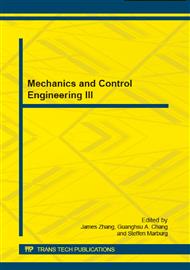p.336
p.341
p.345
p.350
p.357
p.362
p.368
p.373
p.380
New Sliding Mode Controller Based on Second Order Reachability Law
Abstract:
Sliding mode control systems provide robust and simple means for controlling linear and nonlinear plants whose parameters may vary within known boundaries. The existence of an ideal sliding mode requires fast switching, which induces chattering in the system, may excite high frequency plant dynamics and consequently affect the stability of the system. This paper proposes a new simple sliding mode controller based on second order reachability law. The reachability condition in this paper is based not only on the first derivative of the switching function but also on its second derivative. The proposed controller alleviates chattering, guarantees zero steady state error, and offers smooth transients for the system states. To demonstrate the validity of the proposed controller, a second order system is used as a workbench example. The simulation results of the workbench example using MATLAB illustrate the feasibility and efficacy of the proposed controller.
Info:
Periodical:
Pages:
357-361
Citation:
Online since:
December 2014
Authors:
Keywords:
Price:
Сopyright:
© 2015 Trans Tech Publications Ltd. All Rights Reserved
Share:
Citation:


